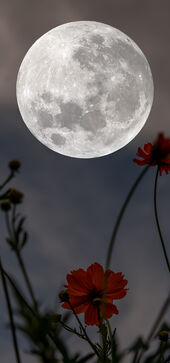
How to Create a Unique Look Based on Your Astrological Chart
Learn how astrology and glamour magic can help you develop a unique, authentic sense of style.
Getty/Onkamon Buasorn
Even humans in the earliest major civilizations, along the Nile and the Euphrates, used the moon’s cycle to inform their farming practices. These planters may have believed that sowing their crops by the moon’s phases or by the zodiac would increase their harvests while avoiding diseases and pests.
In America, it was the German colonists who brought with them a long history of astrological omens, activities, and magical folk beliefs. Germans do not often come to mind in the general imagination of Appalachia, yet they are responsible for some of the strangest and most delightful aspects of folk magic in the mountains. As Appalachians mingled their cultures and bloodlines, German folk spiritual and cosmological beliefs were adopted by many others in the region.
One of the main ways that these astrological ideas were shared and recorded was the almanac. These publications were printed booklets of graphs, astrological information, calendars, and more, and were used for making weather predictions and deciding when to plant different crops, perform household tasks, and even cut one’s hair. They were also used to spread and share occult information as well as folk healing practices and recipes.
The moon has been the constant watcher of humanity since our beginning. The brilliant shining light illuminating the darkness that brought predators and marauders cast a benevolence upon us when we shivered in the night. The idea of planting in accordance with the moon phases is based upon the idea that the moon moves the tides and earthly water, so why not the water within a plant or seed?
During the first quarter of the moon, it is best to plant the following vegetables: asparagus, broccoli, brussels sprouts, barley, cabbage, cauliflower, celery, cucumbers, corn, cress, endive, kohlrabi, lettuce, leeks, oats, onions, parsley, and spinach, as well as seeds of flowering plants.
However, avoid the first day of the full moon for planting and the days on which it changes quarters.
During the second quarter of the moon, it is best to plant beans, eggplant, muskmelon, peas (it is said that peas should be planted as near to noon as possible and some say that it is best to plant them on the new moon, though, as in all occult arts, opinions differ), peppers, pumpkin, squash, tomatoes, and watermelon.
When possible, plant seeds while the moon is in the most fruitful signs of Cancer, Scorpio, or Pisces. If that cannot be done, the next best signs are Taurus and Capricorn.
During the third quarter of the moon, it is best to plant the following vegetables: artichoke, beets, carrots, chicory, parsnips, potatoes, radish, rutabaga, turnip, and all bulbous flowering plants.
During the fourth, or last, quarter of the moon, the tasks of life can be turned away from planting and focused upon other necessary work. Instead, prepare the soil, and then weed and deal with the plants’ pests and diseases.
These types of tasks, where the old or diseased growth is pruned out, are best done when the moon is in the barren signs of Gemini, Leo, and Virgo.
In Appalachian tradition, it’s essential to use the signs and moon phases to plant each crop at the right time. Here is some basic guidance for common crops:
Potatoes prefer to be planted when the signs are in the feet, at the new moon, a belief that comes from the German Appalachian tradition.
Corn does best when planted as the moon is becoming full, or better yet, when it is full.
Beets also love to be planted at the full of the moon, in the sign of Gemini or Cancer.
Beans prefer the full moon, and all the better if you plant them in new ground. The time of day can also be helpful in astrological planting, and beans prefer to be planted in the dark of night on Good Friday.
Cucumbers do best when planted at the last quarter of the new moon, especially in the sign of Gemini. If you plant them on the full moon, it is said they will be all runner vines and hardly any fruit.
Mustard greens and sweet potatoes, however, thrive if planted at the full moon.
Onions imitate the moon, for if the moon is just a sliver when they are planted, they will not root well and will come up out of the ground.
Peas are less picky and do best when planted the day after the full moon or the new moon, especially if the apple trees are in bloom.
Tomatoes do best on the second or third day after a full moon.

Get this article and many more delivered straight to your inbox weekly.